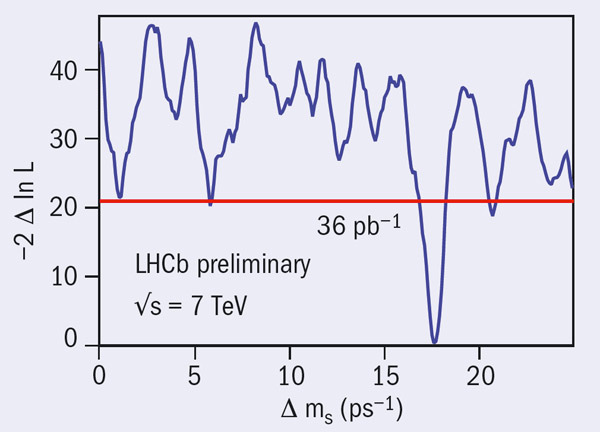
In analysing data from the 2010 running of the LHC, the LHCb collaboration has made some important measurements of the oscillation properties of Bs mesons.
In the Bs system, the Bs and the Bs are mixtures of mass eigenstates that differ in mass by Δms and it this difference that determines the frequency of the oscillations between the Bs and BBs states. It also modifies the probability distribution for the proper time for B0s decays. To measure Δms, the collaboration analysed some 1350 candidates for four decays of the kind B0s → D–sπ and B0s → Ds3π, which were selected from 36 pb–1 of data collected in 2010 at 7 TeV in the centre-of-mass. The team measured the proper decay times for these events, tagging them according to whether they corresponded to un-mixed or mixed decay, i.e. whether the production and decay flavour are the same or opposite, respectively. The preliminary result yields a result of Δms = 17.63 ± 0.11 (stat.) ± 0.04 (syst.) ps–1 (LHCb collaboration 2011a). This is to be compared with the previous best measurement in the world, from the CDF experiment at the Tevatron, of 17.77 ± 0.10 (stat.) ± 0.07 (syst.) ps–1 (CDF collaboration 2006).
The Bs can also decay to J/Ψφ, either by Bs → Bs oscillation or directly, and the interference between these two decay modes gives rise to the CP-violating phase φs. The LHCb collaboration has made its first measurement of this phase using 836 Bs → J/Ψφ signal candidates from the same 2010 data sample used to determine Δms. In the Standard Model, φs is approximately equal to the angle –2βs from a unitarity triangle of the Cabibbo-Kobayashi-Maskawa matrix, and global fits to data give –2βs = (0.0363 ± 0.0017) rad. The Tevatron experiments – CDF and DØ – have reported values for φs that are somewhat inconsistent with the Standard Model expectation, so this is a crucial measurement for LHCb. The first result from last year’s data is consistent with the Tevatron results, but not yet as precise (LHCb collaboration 2011b). However, the LHCb experiment has already taken enough data this year to make a much more precise measurement, and will be able to clarify whether there is any sign of new physics in this decay.
Further reading
CDF collaboration 2006 Phys. Rev. Lett. 97 2423003.
LHCb collaboration 2011a LHCb-CONF-2011-005.
LHCb collaboration 2011b LHCb-CONF-2011-006.







